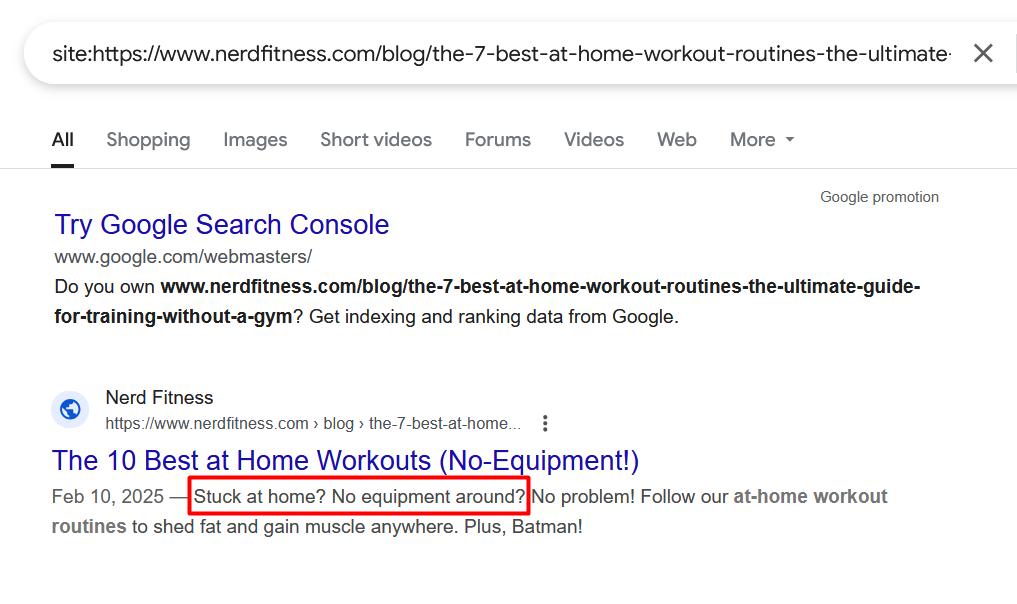Mighty things come in small packages, and the meta description is exactly that. It represents your business in the search results by:
- Summarizing and contextualizing content
- Attracting page clicks and website traffic
- Supporting your branding
- Contributing to customer trust and loyalty
- Outsmarting the competition
It’s unbelievable that 25% of the top-ranking pages don’t have custom meta descriptions, allowing Google to choose whatever text it prefers to show.
This article is your ultimate guide to harvesting all of the meta description’s benefits in a minute, with expert tips from those who already know how to write meta descriptions that convert and advice on mistakes to avoid. Meanwhile, let’s look at a meta description, shall we?
What Is a Meta Description?
In technical terms, meta descriptions are metadata—HTML attributes that provide context about titles and pages across the web. To put it simpler, they are short webpage summaries.
You’ll spot them straight below blue clickable links on a search engine results page (SERP).
They tell searchers what your page is about before they click. Metaphorically speaking, they are like movie trailers—a sentence or two to capture people’s attention, and convince them to visit your site.
Why Businesses Need Meta Descriptions
If you read the Ahref study linked at the top of this article, you’ll know that Google rewrites meta descriptions 62.78% of the time. You might be thinking, “Should I still bother writing a meta description?”
The straightforward answer is yes, you should. But there’s more to know.
Can a Meta Description Help Rank the Page Higher?
Nope. (At least not directly.)
That’s because:
- Google officially removed meta description tags from the ranking factors in 2009.
- Yahoo did the same shortly afterward.
- In 2014, Bing declared that “the meta keywords tag is dead in terms of SEO value” and stopped relying on meta tags as a direct ranking factor overall.
However!
Yahoo, Bing, and other search engines do have some peculiarities. For example:
Yahoo uses meta tags, including descriptions, as the very last thing to rank pages if it doesn’t find any other factors. And Bing’s algorithms turn to those for spam indicators. That’s why tools like Yoast SEO still recommend including them.
If Meta Descriptions Are Not a Ranking Factor, Why Are They Important?
Here’s why:
- They contextualize your meta title and summarize your webpage’s content. This way, people will clearly understand what to expect and be more likely to click and stay on your site.
- They improve your click-through rate (CTR) and organic traffic.
- They demonstrate bits of your brand identity (voice and tone) and differentiate you from competitors.
- They create a more professional and trustworthy company image.
- They can help you outperform your competitors and “steal” clicks from them (we’ll show you how with one trick—just wait for it).
Finally, once people land on your webpage and hang around (on-page engagement) instead of leaving like bored party guests, Google receives a nice little note: “This content is relevant to the search query.” If this happens repeatedly over time, Google can potentially rank your pages higher and bump you up the SERP.
How to Write a Meta Description
1. Make It Informative and To-the-Point
To create a successful meta description, you must know exactly what your target audience hopes to find: the search intent.
For Product Pages
Working in the playground equipment retail industry, Lacey Jarvis, COO at AAA State of Play, remarks, “If you’re writing a meta description for a product page, it would be better to enumerate its primary features or benefits. Today’s searchers are skimmers, not readers. They also scan multiple results to compare products. Lists are easier to skim and do a quick comparison.”
For example:
The company describes the playset with a bullet list of key components and advantages from the product description.
For Blog Pages
Consider these variations:
- Mini-summary (default format)
- Definition
- Checklist
- Steps (ie. “Step 1.____ Step 2. ____, etc.”)
- Number or percentage
- Question hook (ie. “Struggling with [problem]?”)
For example:
Let’s take financial services and assume that people would like to find out what a debt relief program is. Give them an explanation (definition) right away.
Avoid: Irrelevance
If your meta description doesn’t do a good job of contextualizing the content or is otherwise low quality, Google will rewrite it for you (and not always for the best).
Also Avoid: Deception
Don’t (ever!) deceive searchers. False promises about what’s on the page can drop your engagement rate. What’s worse, all those people quickly exiting your site will signal to Google that it doesn’t fulfill the query and should be ranked lower.
2. Add Keywords and Calls-to-Action (CTAs)
Keywords
According to Neil Patel, you may get a 5.7% higher CTR when the exact match search query appears in your meta description. Google usually highlights the keyword(s) in bold to make it stand out to the searcher.
So, don’t be afraid to incorporate long-tail keywords in your meta descriptions.
For local brands, in particular, Adrian Iorga, Founder & President of 617 Boston Movers, also recommends tapping into geographic keyword optimization for local SEO. “If you want to write a great meta description for your local business, pick location-driven keywords. These can be geo-targeted keywords based on your state, region, city, neighborhood, or even street.”
For example:
The brand added geographic long-tail keywords like the “top local movers in Boston” or “professional long distance movers Boston.”
Or, let’s dig into the construction field. See how the Hasler Homes team does that with “custom built homes in Vancouver.”
CTAs
- Informational CTAs → Keep reading. Learn more. Find out how.
- Action-oriented CTAs → Shop now. Try it today. Download your free guide.
- Intrigue-evoking CTAs → Read on to discover the answer. Get your mind blown out with #3.
Pro tip: Add an exclamation mark to your CTA to make it even more convincing.
For example:
Look at this meta description from Kitimat Bound with a CTA: “Start your journey today!”
Avoid: Over-Stuffing
Whether with buy-buy-buy CTAs or with keyword oversaturation, the search algorithms may count excessive use of a word or phrase as spammy behavior on your side.
3. Stick to the Adequate Length
How long should a meta description be? Technically, there’s no limit, but Google cuts off snippets longer than 160 characters, so use that as your maximum.
Why does it matter?
Samuel Charmetant, Founder of ArtMajeur by YourArt, explains it from the aesthetic viewpoint: “Human brains crave completion and perfection. And when you create meta descriptions that get abridged, truncation dots at the end hint at unfinishedness. They break the completeness pattern, as if something were missing, and ruin the aesthetic balance, too, creating disharmony in the layout.”
Ideally, the best length for a meta description would be between 120 and 150 characters.
For example:
Here’s a concise text featuring the contemporary artist’s bio at ArtMajeur.
Avoid: Overly long/short texts
Google trims meta descriptions at even fewer than 160 characters on mobile screens. However, you don’t want to make them too short, either! How would you inform the reader and insert all the needed keywords and CTAs, then, huh?
4. Keep It Exclusive, Fresh, and Aligned with the Title
Ah yes, that sweet siren song of Ctrl+C and Ctrl+V…
Don’t fall for the low-effort, copy-and-paste temptation when creating meta descriptions. This is especially relevant for high-volume content, like product pages, where it would be easy to just reuse the same meta description over and over. But search engines don’t like duplicate meta description tags, and might think that the pages are also the same (and only show one in the SERP). Likewise, your meta descriptions shouldn’t seem a déjà vu for searchers.
To save time, use AI tools to write a meta description (an exceptional one!) for each webpage:
- AI Meta Generator from Yoast SEO
- Optimo
- Free Meta Description Generator by Dashword
- Jasper.ai
- Eskritor
Also, make sure to sync meta descriptions with meta titles. For instance, if you update years (let’s say switching from 2024 to 2025), do it in both places. This is particularly relevant for travel and tourism blogs with guides like: “A Complete Guide to Planning a Trip in 2025.”
Also be extra careful with numbers. For example:
HubSpot’s article with customer newsletter templates ranks in Google’s top ten results. Yet, the meta description confuses the reader and undermines trust. How many email templates are actually inside: 45 or 24?
Avoid: Copy-Pasting (You already know why.)
5. Learn from Your Competitors
How about doing a competitive analysis and snagging creative ideas from businesses in your niche?
No, we are not asking you to “shovel” hundreds of Google’s SERPs.
There’s a much simpler way to do that. Use the site: operator (one of Google’s search hacks) for domain or URL-specific searches. Type site:competitordomain.com in the search bar—and voilà. You’ll get the whole list of their website pages indexed by Google.
For example:
Suppose you run a health and wellness business and need to create a content strategy for your blog. Scroll through blog content ideas from your competitor and analyze their meta descriptions. Let’s take this article from Nerd Fitness.
You can notice that the brand begins with question hooks: “Stuck at home? No equipment around?” There are also several exclamation marks for higher persuasion. Why not copycat (not copy-paste!) this tactic when writing your own meta descriptions to optimize your blog posts for conversions?
Avoid: Copy-Pasting
This time the copy-paste would not only be content duplicating, it would also be stealing, aka plagiarizing.
Bonus Tip: Run Tests and Experiment with Icons and Emojis
Testing is super-useful with finding meta descriptions that convert.
Experimenting with emojis and universal characters in your meta description is another leap forward. Bet your competitors haven’t done it yet, so you can become the frontrunner (and the click winner!).
Symbols and emojis actually mean nothing to ranking algorithms and direct SEO. Instead, they act as fun attention-grabbers to make you stand out from the competition in SERP and win more clicks (not much more—3.4% according to research—but that’s still something!).
Sometimes you can direct people’s attention, quite literally, by pointing a finger or an arrow
emoji.
Nicolas Breedlove, CEO of PlaygroundEquipment.com, claims, “Younger audiences prefer emoji language in communication, so it’s a must-try practice for writing meta descriptions if you target that very demographic segment. Particularly, this is critical when you’re targeting Gen Z customers who, as digital natives, are more accustomed to emojis.”
How to Add a Meta Description to Your Content
Use Plugins
Got a WordPress website? Lucky you! Just pick a WordPress SEO plugin to help you write a compelling meta description:
- Yoast SEO
- AIOSEO
- Rank Math
- SEOPress
- Squirrly SEO
For example:
Yoast SEO suggests AI-generated meta texts and gives a “green light” when your snippet looks good.
Type Manually
Not a WordPress person? You can either hire a web developer to “meta-morph” your code, or drop it yourself after the title tag:
It’s Your Turn to Write SEO-Friendly Meta Descriptions
You have got all the best strategies on how to write a meta description, all the necessary tools, and now—zero excuses. With this knowledge your meta descriptions will impress both crawlers (search engines) and clickers (people).
Let your metadata be a traffic magnet for your business.














